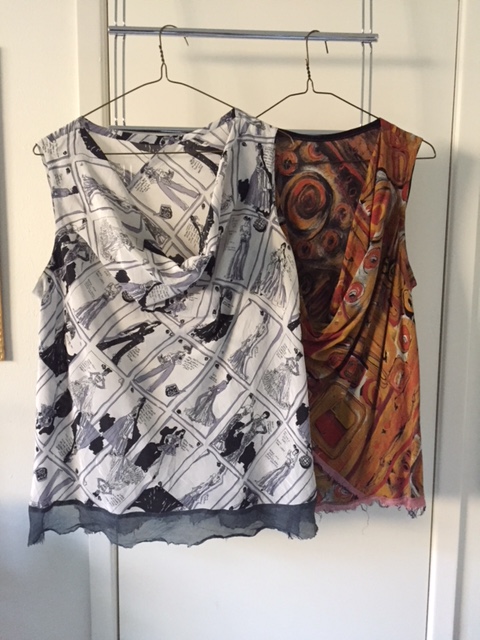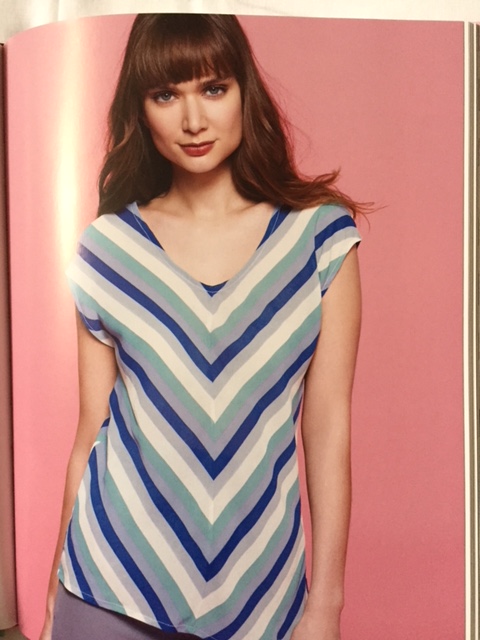
When the woven fabric is turned on a 45 degree angle, the warp and weft (lengthwise and crosswise yarns) are diagonal. Your fabric is now on the Bias Fabric Grain, a change made entirely by the user. What happens when you hold up a piece of fabric diagonally, aka the bias? The world changes! It will change properties and behavior of the fabric.
(Important Note for beginners: Bias Fabric Grain is not to be confused with bias binding. What’s the difference? This writer with the wonderfully named website explains it well in her post. Go check out cucicucicoo.com)
- Crisp fabrics become drapey.
- The fabric magically acquires stretch properties. (That is why, a knit/jersey garment (which has built in stretch) will create difficulties when we try to make it on the bias.)
- Did you know that fabric cut on the bias will not ravel at the edges?
- Fabric cut on the diagonal loses some sturdiness and strength, overall. The bias grain is a delicate entity, depending on the fiber content and weave.
- Tightly woven cottons will gain flattering drape, but will be sturdy enough to handle easily, while a soft rayon or silk will need some serious handling skills when they’re on the bias grain. It doesn’t mean they won’t last. Take a look at these cowl neck tops in thin silk crepe (left) and rayon crepe (in fall colors) which has seen extensive rotation in my closet. Oh, and check the raw edges of the organza hem. (Wire hangers have such a rustic charm.)


- Take a look at this bias gown by Madame Vionnet, sewn up in the 1930s — its holding up quite well —- this one is being pampered in a museum, though.
Images borrowed from the book “Madeleine Vionnet” by Betty Kirk, published by Chronicle Books
- Sewing on the bias will require that you make changes in your sewing methods. That’s another post.
- Clothing made on the bias has a flattering way of skimming the body. I love things made on the bias grain – I think I’ve made it obvious in this post.

The image above is borrowed from the book “The Great British Sewing Bee, From Stitch to Style” by Wendy Gardner, published by Quadrille Publishing. Photographer: Jenni Hare. Courtesy Love Productions. Don’t want to miss any credits.
Beginning sewers, are you finding these posts helpful? Experienced sewers, please chime in with any info I might have missed. These posts are meant to clarify the concept of fabric grain to beginners, and I have not included actual sewing tips.
Happy Holiday Season! Go and sew up a storm.
Samina



I just wanted to add that the warp (lengthwise) and the weft (crossgrain) can have different stretch qualities. Sometimes the piece might hang best if the right and left sides of the garment are mirrored so the grain matches, otherwise the garment can stretch in a spiral around the body, which i find uncomfortable. If the front and back pieces are cut in one with no center seam, this is what wold happen.
LikeLiked by 2 people
Thank you for the great tip, Cynthia!
LikeLiked by 1 person
There’s that infamous cowl neckline! Great information Samina!
LikeLike
Yep. It is, Faye. I still love cowls 😊
LikeLike
Nice projects! I like them very much! I like to visit your blog very much. Thanks for sharing photos. I admire your work. I am waiting for more projects
LikeLiked by 1 person
Thank you!
LikeLike
This is a great informative article! Thanks so much for linking up to my sewing lesson, too! 🙂 Lisa
LikeLiked by 1 person
You are welcome! Love your website.
LikeLike